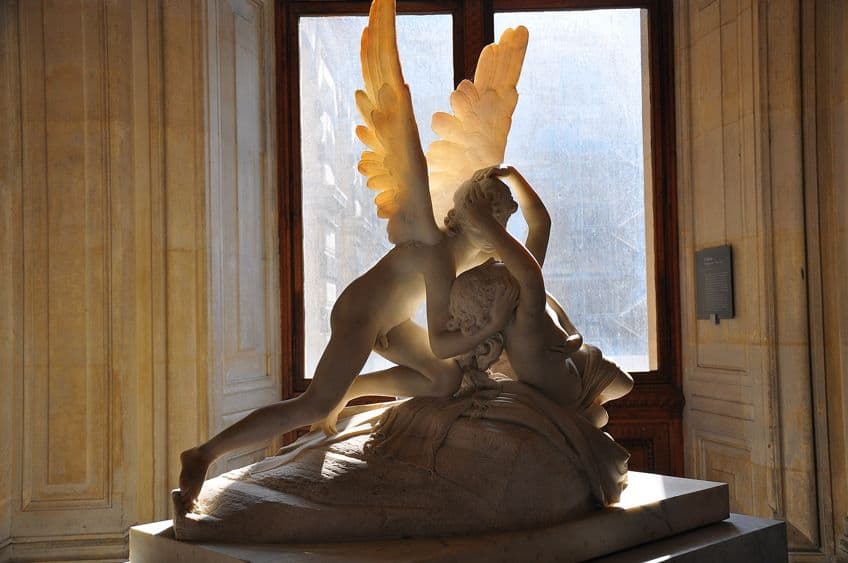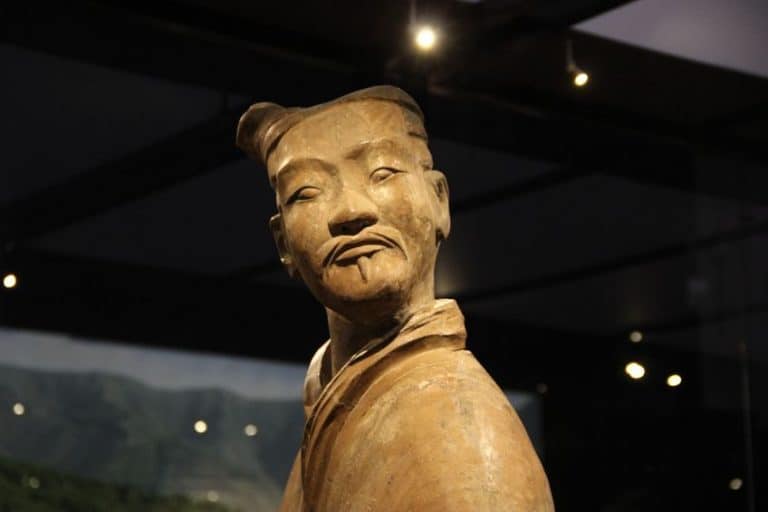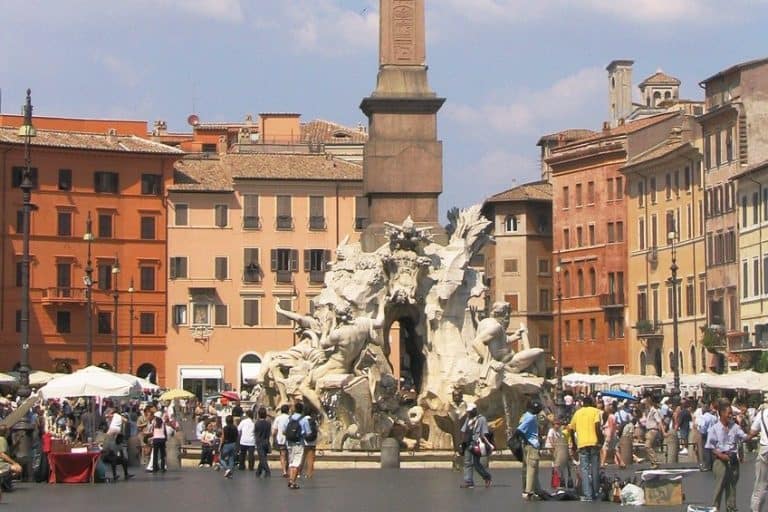“Psyche Revived by Cupid’s Kiss” by Antonio Canova – An Analysis
Mythological stories have been the source of inspiration for artists for centuries and when names like Cupid crop up, it undoubtedly evokes ideas of love and arrows! This article will explore a tale that involves Cupid, however, here he is carved into marble with his beloved Psyche in the sculpture by Neoclassical artist Antonio Canova titled Psyche Revived by Cupid’s Kiss (1787 – 1793).
Table of Contents
Artist Abstract: Who Was Antonio Canova?
The Italian Antonio Canova was born on November 1, 1757, in Possagno, Italy, and died on October 13, 1822, in Venice. He was exposed to the modality of sculpture from an early age by his grandfather Pasino Canova, who was also a sculptor and stonemason. He worked in the Neoclassical art style creating mythological and religious subject matter. He received a variety of commissions from elite patrons and was established as a renowned sculptor. Some of his sculptures include Daedalus and Icarus (1777 – 1779), Theseus and the Minotaur (1781 – 1782), and The Three Graces (1814 – 1817).

Psyche Revived by Cupid’s Kiss (1787 – 1793) by Antonio Canova
This article will discuss the marble Cupid and Psyche statue titled Psyche Revived by Cupid’s Kiss by Antonio Canova. It will first expand on the time period it was made, including an explanation of the different versions and who commissioned them, which will be followed by a discussion of the subject matter and the formal art qualities.
| Artist | Antonio Canova |
| Date Painted | Between 1787 – 1793 |
| Medium | Marble |
| Genre | Sculpture |
| Period/Movement | Neoclassicism |
| Dimensions (cm) | 155 x 168 x 101 |
| Series/Versions | There are two versions. |
| Where Is It Housed? | The first version is at the Musée du Louvre in Paris, France. The second version, from 1796, is at the State Hermitage Museum in Saint Petersburg, Russia. |
| What It Is Worth | The price is uncertain. |
Contextual Analysis: A Brief Socio-Historical Overview
Antonio Canova created two Psyche Revived by Cupid’s Kiss statues; the first version was commissioned by Colonel John Campbell in 1787, and the second version, which is titled Cupid and Psyche, was reportedly created for Prince Nikolai Yusupov in 1796. Reportedly, Colonel John Campbell did not have the funds for the Eros and Psyche statue and one of its later owners became Joachim Murat, who was Napoleon’s brother-in-law, King of Naples from 1808 to 1815, Marshal of France, among other accolades.
Murat reportedly acquired the sculpture in 1800 and the Musée du Louvre acquired it in March 1809.
The second version is housed at the Hermitage Museum in Saint Petersburg, Russia, and was acquired in 1926 from the State Museum Fund and was previously in the collection of Prince Yusupov. It measures 148 by 172 centimeters. Interestingly, there is also a full-scale model of the Eros and Psyche statue in the Metropolitan Museum of Art in New York. It was created in 1794 as a preparatory copy for the second version. It was created with plaster and measures 134.6 by 151.1 by 81.3 centimeters.
The Advent of Neoclassicism
To understand any artworks by Antonio Canova will require an understanding of the Neoclassicism art movement and several of the important discoveries made that catalyzed it. Although Canova was a Neoclassical sculptor, the ideals from this art style also spanned other modalities like painting, architecture, and music. Neoclassicism started around the 1750s and lasted until the 1850s in Europe. It was defined by its reversion to and revival of ancient Greek and Roman art and ideas, which is also referred to as “classical antiquity”.

The cornerstone archaeological discoveries in 1738 of Herculaneum and in 1748 of Pompeii, two ancient Roman cities, contributed to Neoclassicism’s artistic expressions of ideals of harmony, proportion, symmetry, and order, among others.
Other influences included the theories of the German archaeologist and scholar Johann Joachim Winckelmann who wrote seminal texts like Reflections on the Imitation of Greek Works in Painting and Sculpture (c. 1755), which discussed the notions around imitating the ancient Greeks.
Furthermore, the Enlightenment, otherwise termed the “Age of Reason”, was another contributing influence on Neoclassical art.
It has been described as philosophical and political in its development turning to the rational or reason-based faculties embedded in science to understand life and society. It was a time of expansion, not only of the human mind but of society.
Inspiration for the Eros and Cupid Statue
The inspiration behind Psyche Revived by Cupid’s Kiss by Antonio Canova was reportedly inspired by the Roman writer and philosopher Lucius Apuleius and his novel titled The Golden Ass (also titled Metamorphoses) (c. Late 2nd century AD). Apuleius’s novel also includes the story about Cupid and Psyche.
While this is a brief description of the story involving Cupid and Psyche, it explains the storyline that Antonio Canova drew inspiration from, and notably the climax of the story when Psyche is saved by Cupid.
The story follows Psyche who tries to be reunited with Cupid, who saved her from the disastrous fate of marrying a dragon or horrible creature, which was really a curse instigated by the goddess Venus who was jealous of Psyche’s beauty.

When Psyche was about to be taken to her new husband, she was transported to a beautiful palatial place where she and Cupid spent their nights together, however, Psyche could not look at him. She started doubting who he was – maybe he was the dragon after all – and she attempted to kill him, as advised by her sisters’ speculation about who he was.
One night, when Psyche was about to kill Cupid with a knife, she shone a light on him and discovered it was Cupid and not a monster. He woke up from droplets of hot lamp oil that got onto his skin, and he flew away from her because she did what he ordered her not to do, which was to see who he was.
In Psyche’s attempts to be reunited with him, she eventually consulted Venus who ordered her to do several near-impossible tasks, of which the final task included her traveling to the underworld to obtain a flask with a “beauty ointment” belonging to Proserpina, the goddess of the underworld.
When Psyche looked inside the flask to use the ointment, she fell into a deep sleep. She was eventually saved by Cupid who removed the sleep from her eyes and woke her with a poke of an arrow. She was roused to life again and the loving couple were married.
Formal Analysis: A Brief Compositional Overview
In the formal analysis of the Eros and Psyche statue, Psyche Revived by Cupid’s Kiss by Antonio Canova, a visual description will discuss the subject matter in more detail, which will be followed by an explanation of how the art elements are composed, creating this marble sculpture. It is important to note that the formal analysis below will focus specifically on the version of the Eros and Psyche statue that is held at the Musée du Louvre in Paris.

Subject Matter: Visual Description
Psyche Revived by Cupid’s Kiss depicts Cupid holding the loose-lying body of Psyche in his arms; his left arm is around her upper torso with his left hand over her right breast. His right hand is cupping and cradling her head as she appears to be roused back to life with Cupid gazing intently at her.
Cupid’s body posture is hunched over, resting on his left knee while his right leg is straight out behind him, stabilizing him while he holds onto Psyche, who is lying on her right side; her right leg is loosely out ahead of her, and her left leg is bent at the knee.
Psyche’s head is tilted back, looking up at Cupid, and her long hair drapes behind her while both her arms are raised up and her hands are lightly touching Cupid’s curly-haired head as if she intends to embrace him.

Both are portrayed in the nude except for Psyche who has a piece of fabric loosely draped over her left leg and over her genitalia and she is lying on top. Cupid is portrayed with a set of wings in his back and a quiver with arrows attached to his left side. A jar/flask lies behind Psyche’s back including an arrow next to it.
Color
The Eros and Psyche statue is made of marble and does not have any other color painted over it. The marble appears as a soft white.

Texture
Texture plays a large role in any marble sculpture, and this Cupid and Psyche statue by Antonio Canova eloquently and skilfully left us, the viewers, with the impression of soft and hard contrasts. Canova was reportedly well-known for his methods of smoothing, polishing, and refining his marble sculptures, which would be based on his preparatory clay models. For example, notice the soft folds of the fabric draped over Psyche, or the softer, and finer, curls of Psyche and Cupid’s hair, including Cupid’s feathered wings.
These contrast with the harder appearance of the jar/flask behind Psyche as well as the coarser texture of the slab of marble upon which the two are created.

Line
Psyche Revived by Cupid’s Kiss by Antonio Canova is composed of a variety of lines that lead us, the viewers, to gaze up and around the structure. For example, notice the naturalistic lines of the two figures’ bodies. Furthermore, a more diagonal line is created by Psyche’s body posture as she reaches up to Cupid, who appears more vertical in his posture. The verticality of Cupid’s wings also appears straighter in linearity compared to the rounder linearity of Psyche’s arms reaching upwards, which creates a subtle contrast between the two figures.

Shape and Form
The sculpture Psyche Revived by Cupid’s Kiss by Antonio Canova is a three-dimensional form because it can be walked around and observed from all directions. The form is described in terms of height, width, and depth, which contrasts with shapes, which are described as two-dimensional with only width and height.
Furthermore, the Cupid and Psyche statue appears as an organic or naturalistic form, which is based on real life and the patterns on the jar/flask and Cupid’s quiver appear floral in their shapes.

Space
Psyche Revived by Cupid’s Kiss by Antonio Canova is a large sculpture that allows interaction of its space, in other words, it allows us, the viewers, to walk around it and investigate it from all angles. It is a complete three-dimensional space versus a more two-dimensional space of a canvas.

A Love Set in Stone
Psyche Revived by Cupid’s Kiss by Antonio Canova is one of the artist’s greatest marble sculptures still standing today and, although it’s regarded as Neoclassical, it has also been described as teetering on the stylistic edges of Romanticism. The latter was an art movement that developed around the 1780s, giving way to more self-expression as is evident in the emotive moment when Canova’s Cupid awakens Psyche.

This article explored the first version of Antonio Canova’s “Psyche Revived by Cupid’s Kiss”, which is housed in the Musée du Louvre in Paris. However, the second version is on par in stylistic beauty and skill, and both are life-sized testimonies of a mythological tale of a love that will forever be set in stone.
https://www.youtube.com/watch?v=XgMHTnZTyeU
Frequently Asked Questions
Who Made the Eros and Psyche Statue?
The Neoclassical sculptor, Antonio Canova, created the marble sculpture titled Psyche Revived by Cupid’s Kiss (1787 – 1793), which measures 155 x 168 x 101 centimeters. Its location is the Musée du Louvre in Paris, France.
How Many Versions Are There of the Sculpture Psyche Revived by Cupid’s Kiss by Antonio Canova?
There are two original versions created by Antonio Canova of Psyche and Cupid. The first version is Psyche Revived by Cupid’s Kiss, which is housed at the Musée du Louvre in Paris, France. The second version, titled Cupid and Psyche, is at the State Hermitage Museum in Saint Petersburg, Russia.
Who Commissioned Psyche Revived by Cupid’s Kiss by Antonio Canova?
The first version of Psyche Revived by Cupid’s Kiss was commissioned by Colonel John Campbell in 1787. The second version was created for Prince Nikolai Yusupov in 1796.
Alicia du Plessis is a multidisciplinary writer. She completed her Bachelor of Arts degree, majoring in Art History and Classical Civilization, as well as two Honors, namely, in Art History and Education and Development, at the University of KwaZulu-Natal, South Africa. For her main Honors project in Art History, she explored perceptions of the San Bushmen’s identity and the concept of the “Other”. She has also looked at the use of photography in art and how it has been used to portray people’s lives.
Alicia’s other areas of interest in Art History include the process of writing about Art History and how to analyze paintings. Some of her favorite art movements include Impressionism and German Expressionism. She is yet to complete her Masters in Art History (she would like to do this abroad in Europe) having given it some time to first develop more professional experience with the interest to one day lecture it too.
Alicia has been working for artincontext.com since 2021 as an author and art history expert. She has specialized in painting analysis and is covering most of our painting analysis.
Learn more about Alicia du Plessis and the Art in Context Team.
Cite this Article
Alicia, du Plessis, ““Psyche Revived by Cupid’s Kiss” by Antonio Canova – An Analysis.” Art in Context. June 30, 2023. URL: https://artincontext.org/psyche-revived-by-cupids-kiss-by-antonio-canova/
du Plessis, A. (2023, 30 June). “Psyche Revived by Cupid’s Kiss” by Antonio Canova – An Analysis. Art in Context. https://artincontext.org/psyche-revived-by-cupids-kiss-by-antonio-canova/
du Plessis, Alicia. ““Psyche Revived by Cupid’s Kiss” by Antonio Canova – An Analysis.” Art in Context, June 30, 2023. https://artincontext.org/psyche-revived-by-cupids-kiss-by-antonio-canova/.











